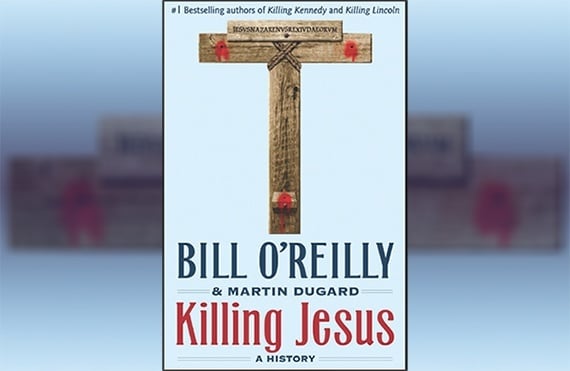This article first appeared in the CHRISTIAN RESEARCH JOURNAL, volume 37, number 01 (2014). The full text of this article in PDF format can be obtained by clicking here. For further information or to subscribe to the CHRISTIAN RESEARCH JOURNAL go to: http://www.equip.org/christian-research-journal/
Bill O’Reilly and Martin Dugard have teamed up to produce another historical bestseller like their earlier Killing Lincoln (2011) and Killing Kennedy (2012). Their goal in this latest book is to tell the full story behind the struggle between good and evil (p. 4) that led to the killing of Jesus (which they say happened on April 7, AD 30 at 3 p.m. [242]). Both authors are Roman Catholics who take the historical details in the Gospels seriously. They also have interpreted the historical events leading up to the crucifixion of Jesus within a moral context that is consistent with a Christian worldview. However, their attempt to separate “fact from myth” (273), but not to convert “anyone to a spiritual cause” (2–3), has led to an incomplete and somewhat disappointing work.
Details of the Life of Jesus. Killing Jesus begins with the birth and early life of Jesus juxtaposed with a fine section on Roman history that goes back to the life and death of Julius Caesar, and the rise of the empire under Augustus. Next, the public ministry of Jesus is covered. The details largely follow the Gospel of John and, for example, tell about Jesus cleansing the temple early in His ministry. Then the final part of the book describes Passion Week, including the triumphal entry and a second cleansing of the temple (following the Synoptic Gospels). It ends with the arrest, trials, crucifixion, and death of Jesus. As with each chapter, there is an attempt at a literary “cliff hanger” comment to finish this section: “Alone in the darkness of the tomb, Jesus of Nazareth finally rests in peace” (255).
However, this can never be a satisfactory end to the story of the unique life of Jesus, since the same Gospels that provide the historical framework for most of Killing Jesus make His subsequent resurrection the decisive proof for everything else! Thankfully, there are hints that the authors wanted to write more, both about the resurrection and about the supernatural, divine character of Jesus. These can be seen in the brief description of the empty tomb (258–59), the short note about post-resurrection appearances mentioned throughout the New Testament (261), and the survey of the careers of the disciples after Jesus’ death, careers that made a “radical shift” because of their conviction “that they had seen a resurrected Jesus” (263). But the general attempt at neutrality, what the authors think is proper historical methodology, detracts from these otherwise fine comments.
This flawed methodology is perhaps most notable in their attempt to sidestep any decision about the authenticity of Jesus’ miracles. They write that the Jewish authorities are disturbed by “Jesus’s ability to amaze the peasants of Galilee by seemingly performing supernatural acts,” including “allegedly” bringing “a dead girl in Capernaum back to life” (155–56). Later they say that “the legend of Jesus’s raising of Lazarus from the dead” is an issue for the Temple priests (199). However, Killing Jesus wrongly implies these and other Jewish leaders tried to explain away the works done by Jesus as being those of a “charlatan” (156). According to the Gospels, they actually accepted the supernatural nature of the miracles, but tried to say that Jesus’ power to do them did not come from God (Matt. 12:24; Mark 3:22), or violated the Sabbath (e.g. Matt. 12:1–10). The Jewish authorities do not argue that the events only “allegedly” or “seemingly” happened.
Embellished “Facts.” Next, the book is written in the present- tense style of a novel that would appeal to general readers. It should not be considered history in a strict sense since many details presented cannot be known with certainty. The authors do promise to differentiate between what can be known and what is “not set in stone” in the introduction (2), but they seldom follow through on that promise. Presumably, they want the reader to accept nearly everything, including descriptions of what people wore, ate, said, and so on, as being fact based. Moreover, in cases where the authors do have disclaimers (e.g., their statement that “no one knows for sure” about whether a Jewish rebel, Judas of Gamala [death c. AD 6], was crucified or not [n. 82]), there are still pages of conjectural details presented as fact about how this Judas was crucified: “The soldiers of Antipas forced Judas of Gamala to his knees” (82–85). Many of the details provided about crucifixion are correct in general (and are repeated when the crucifixion of Jesus is described), but implying in the text that they all applied in the particular case of Judas is not good history.
Take Our Word for It. Furthermore, the book generally lacks source citations. There is a short general biography with many fine evangelical authors included (275–80), and a few content notes at the bottom of some pages. But there are no real footnotes or endnotes that would link specific facts with the ancient or modern sources for that information, not even when direct quotes are used in the text. The absence of these normal historical references make it nearly impossible to weed out dramatic conjecture from reasonable historical conclusions based on sources.
The presence of numerous historical errors in Killing Jesus also undermines confidence in the research behind the vivid details given without disclaimers. Briefly such mistakes include: (1) saying that the northern kingdom of Israel fell to “Philistines” in 722 BC (n. 14), when it actually fell to the Assyrians (2 Kings 17:5–6); (2) stating that the canonical Jewish Scriptures were compiled “five hundred years before the birth of Christ” (n. 15), when several books such as Ezra, Nehemiah, and Malachi were not even written until c. 430 BC; (3) placing a proclamation of Josephus at “ten years after the Baptist [John] is executed” (152), when Josephus did not write anything until at least fifty years after John was killed; and (4) noting that Pilate calls “the high priest and church elders” to announce his decision to have Jesus whipped (241, emphasis added), when no “church” elders existed at that time.
There are also many historical theories incorporated into Killing Jesus that are highly debatable. The dates given at the start of each chapter are a good example, since, unfortunately, the precision they presume isn’t possible given our existing sources. In other words, it is not possible to know precisely when Christ was born, or when He was crucified. The evidence in the Gospels and elsewhere provides only a range of possible years, and more exact dates depend on the timing of key details such as the date of a lunar eclipse noted by Josephus as happening at the time of the death of Herod the Great. Two eclipses, one in 4 BC, and one in 1 BC could have been the one Josephus described.1 Killing Jesus makes a reasonable guess at 5 BC for Jesus’ birth using the 4 BC eclipse, but even here, 6 BC or perhaps earlier could be correct. Similarly, AD 30 for His death is assumed in the book, but AD 33 is almost equally likely.2 Unfortunately, even aside from their 5 BC/AD 30 assumptions, their frequent statements that Jesus was thirty-six when crucified (“the child with 36 years to live is being hunted” [7]) are still wrong, since there is no year “zero.” In other words, it is only one year from 1 BC to AD 1, and so their presumed age for Jesus at His death should be thirty-five.3
Despite these issues, it should also be mentioned that many, many of the details in Killing Jesus are completely plausible and very likely. For example, when Jesus is praying in the garden of Gethsemane before His arrest, the text says, “The moon is nearly full” (221). This is not just literary creativity. The Jewish lunar calendar begins each month with the first observation of a new moon, and the Passover lambs were killed in the afternoon of the 14th of the month (Exod. 12:6). Since this event was very near the time Jesus was arrested according to the Gospels, it would have been a nearly full moon in the garden that night. Indeed, Killing Jesus probably gets more of these narrative details right than wrong. The problem is that readers have no easy way to tell the difference.
Adding a Little Spin. Finally, as other reviewers have noted, there are occasional hints in Killing Jesus of the particular religious and political views of O’Reilly and Dugard. For example, reflecting Roman Catholic theory, the book says that Peter matures into “the eminently stable ‘rock on which I will build this church’ that Jesus speaks of in Matthew 16:18” (n. 263). Mary the mother of Jesus is also said to be mentioned by the book of Revelation as “‘a woman clothed with the sun’” (265). Of course, non-Roman Catholics interpret these texts differently. Conservative political views have been seen behind the frequent references in the book to high taxes placed on the Jews by the Romans and various Jewish leaders (88–90, 122, 154, 191, etc). Also, Jesus’ words and actions, such as driving out the money changers from the temple, interpreted by O’Reilly and Dugard as an attack against taxes and an illegitimate money flow (228–29), could be seen as reflecting the authors’ modern political views.4 But taxation and financial corruption really were important human issues behind the events that led to Jesus’ crucifixion. The book probably does not overemphasize them.
In short, Killing Jesus is a fine historical novel about the events leading to Jesus’ death, but it fails in its lofty goal of telling fully and factually the whole “incredible” story (7). This is certainly a shame, since it would be nice for evangelicals to be able to applaud wholeheartedly a popular book that otherwise respects the historical reliability of the Bible. —Daniel Hoffman
NOTES
- See, e.g., Harold W. Hoehner, Chronological Aspects of the Life of Christ (Grand Rapids: Zondervan, 1978), 11-13 for a birth date based on the 4 BC eclipse and http://www.askelm.com/star/star010.htm for the 1 BC eclipse.
- For example, Hoehner, Chronological Aspects, 141, holds to the AD 33 date.
- Andreas J. Kostenberger, “Killing Jesus Review,” http://thegospelcoalition.org/book-reviews/review/killing_jesus.
- Among many others, see Joel L. Watts, http://www.huffingtonpost.com/joel-l-watts/review-of-killing-jesus_b_3984134.html and Selina O’Grady, http://www.theguardian.com/books/ 2013/dec/18/killing-jesus-bill-oreilly-review.









